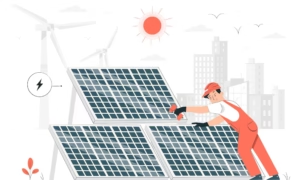Whether it’s due to disease, storm damage, or simply outgrowing its space, there comes a time when a tree on your property may need to be removed. The process of tree removal can be complex, involving various techniques, tools, and safety precautions. Moreover, the cost and necessary permits can be a source of confusion for many homeowners. This comprehensive guide to tree removal will cover everything you need to know, from identifying when a tree needs to be removed, to understanding the costs and legal requirements, to finding a reputable tree removal service.
When is Tree Removal Necessary?
There are several reasons why a tree might need to be removed from your property:
– Disease: A diseased tree can pose a risk to your other trees and even your home if it’s left untreated. Signs of disease include discolored leaves, dead branches, and fungal growth.
– Storm damage: Severe weather can cause trees to become hazardous, with broken limbs or a compromised root system.
– Structural issues: Trees growing too close to your home or other structures can cause damage to foundations, roofs, and utility lines.
– Aesthetic reasons: Sometimes, a tree simply doesn’t fit in with your landscape design or has outgrown its space.
If you’re unsure whether a tree needs to be removed, consult a professional arborist for advice.
Assessing Tree Removal Cost
The cost of tree removal can vary greatly depending on factors such as the tree’s size, location, and complexity of the job. On average, you can expect to pay between $150 and $1,500 for professional tree removal. Some factors that can impact the cost include:
– Tree size: larger trees typically require more work and specialized equipment, resulting in higher costs.
– Accessibility: If the tree is difficult to access, such as being located near power lines or buildings, the job may be more complex and costly.
– Time and labor: The amount of time and manpower needed to complete the job will also affect the price.
– Additional services: Stump removal, limb chipping, and log splitting are often offered as add-on services and can increase the total cost.
To get an accurate estimate for your tree removal project, contact local tree removal companies for quotes.
DIY Tree Removal vs. Professional Tree Removal
While some homeowners may be tempted to tackle tree removal themselves, this can be a dangerous and time-consuming task. Professional tree removal services have the experience, equipment, and insurance to handle the job safely and efficiently. Some of the benefits of hiring a professional include:
– Safety: Professionals are trained in safety procedures and risk management, reducing the chance of accidents or property damage.
– Expertise: Arborists have extensive knowledge of tree biology and can provide valuable advice on tree health and preservation.
– Efficiency: Professional tree removal companies have the necessary equipment to complete the job quickly and minimize disruption to your property.
– Liability: If something goes wrong during a DIY tree removal, you may be held responsible for damages or injuries. Hiring a professional ensures that you’re covered in case of accidents.
Navigating Tree Removal Permits and Regulations
Before embarking on a tree removal project, you should check your local regulations and determine whether a permit is required. Many cities and towns have specific guidelines for tree removal, including requirements for tree preservation and replacement. Failure to obtain the necessary permits can result in fines and penalties.
Some factors that may affect whether a permit is required include:
– Tree size: Permits may be required for the removal of large or mature trees.
– Tree species: Certain species may be protected and require a permit for removal.
– Location: Trees located near public spaces, waterways, or protected areas may be subject to additional regulations.
To avoid any legal issues, consult with your local government or a professional tree removal service before starting your project.
Safety Precautions and Risk Management
Tree removal can be a dangerous task, which is why it’s essential to follow safety guidelines and best practices. Some safety precautions to consider include:
– Hiring a professional: As mentioned earlier, professional tree removal services have the expertise and equipment to handle the job safely.
– Protective gear: Make sure anyone involved in the tree removal process wears appropriate safety gear, including helmets, gloves, and eye protection.
– Assess the area: Before starting the project, survey the area for potential hazards, such as power lines, structures, or other trees.
– Establish a safety zone: Clearly mark a safe area around the tree where bystanders should not enter during the removal process.
– Plan an escape route: In case the tree falls unexpectedly, make sure you have a clear path to safety.
Common Tree Removal Techniques
There are several techniques used in tree removal, each with its own set of advantages and challenges. Some common tree removal methods include:
– Felling: This involves cutting the tree down in one piece, which requires ample space and can be dangerous if not done correctly.
– Sectional dismantling: This method involves removing the tree in sections, either by climbing or using a crane or bucket truck. This is often the preferred method for trees located near structures or power lines.
– Rigging: In this technique, ropes and pulleys are used to lower sections of the tree safely to the ground.
– Stump removal: After the tree has been removed, the stump can either be ground down or removed entirely, depending on your preference and budget.

Tree Removal
Essential Tree Removal Equipment
Professional tree removal companies use a range of specialized equipment to complete the job safely and efficiently. Some essential tree removal tools include:
– Chainsaws: Used for cutting through tree trunks and branches.
– Ropes and pulleys: Utilized in rigging and sectional dismantling techniques.
– Crane or bucket truck: Helpful for accessing tall trees or those in tight spaces.
– Stump grinder: Used to grind down tree stumps after the tree has been removed.
– Safety gear: Helmets, gloves, eye protection, and other safety equipment are crucial for preventing injury during the tree removal process.
Choosing the Right Tree Removal Service
When selecting a tree removal service, consider the following factors:
– Experience: Look for a company with a proven track record and experience in the specific type of tree removal you require.
– Licenses and certifications: Ensure the company is licensed, insured, and employs certified arborists.
– References: Ask for references and read online reviews to gauge the company’s reputation.
– Written estimates: Obtain written quotes from multiple companies to compare prices and services offered.
– Safety practices: Inquire about the company’s safety procedures and equipment to ensure they prioritize safety during the tree removal process.
What to Expect During the Tree Removal Process
Once you’ve hired a tree removal service, the process typically follows these steps:
– Site assessment: The company will assess the tree’s location, size, and condition to determine the best removal technique.
– Preparation: The area will be cleared of any obstacles, and safety precautions will be put in place.
– Tree removal: Depending on the chosen method, the tree will be removed in sections or as a whole.
– Clean up: The company will remove all debris, and additional services such as stump removal or limb chipping may be performed if requested.
– Inspection: A final inspection of the area will be conducted to ensure the job is complete and the site is safe.
Conclusion:
Tree removal can be a complex and potentially dangerous task, but with the right information and professional assistance, it can be a smooth process. By understanding the reasons for tree removal, assessing costs, and navigating permits and safety precautions, you can make the best decision for your property and ensure a successful tree removal project.








































